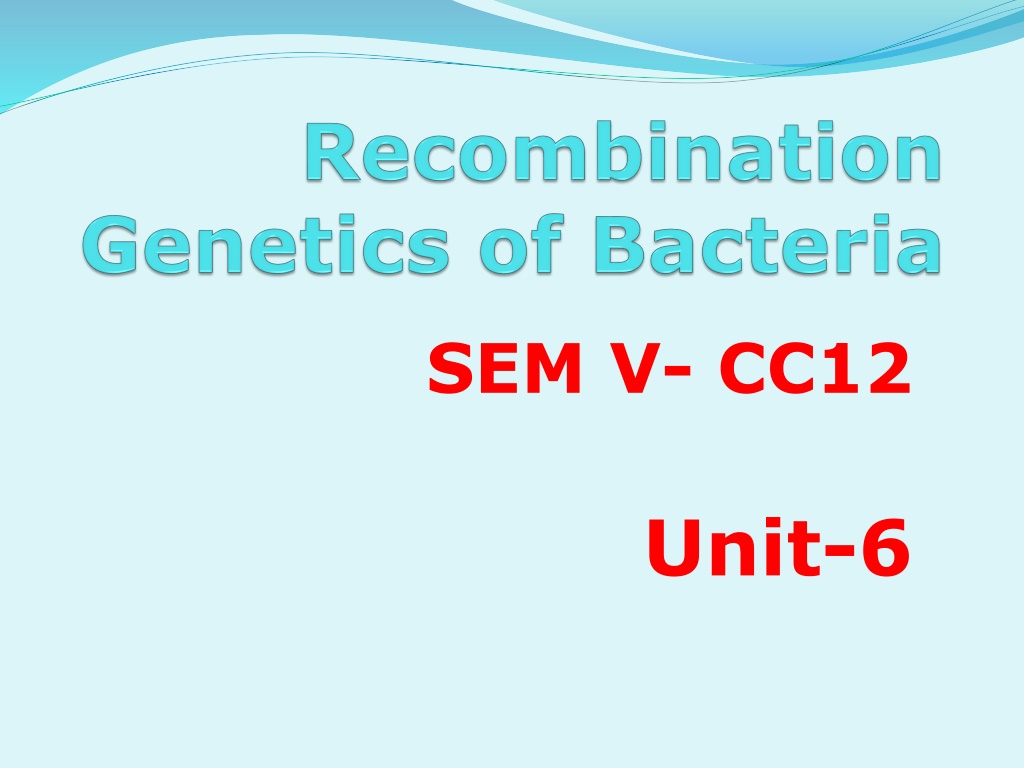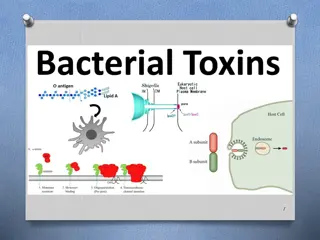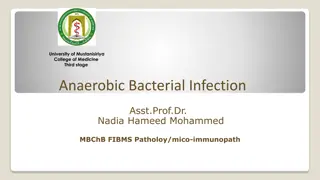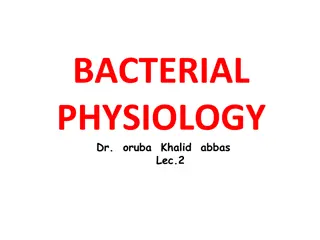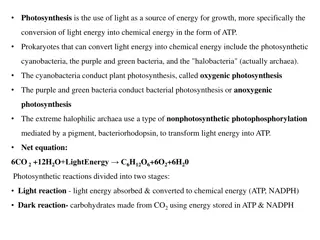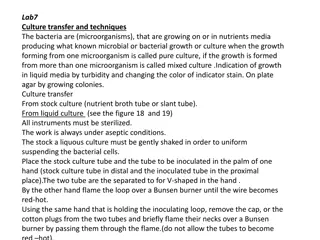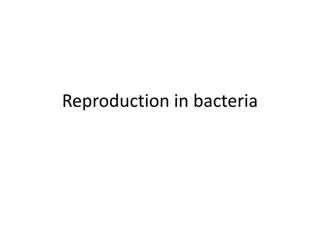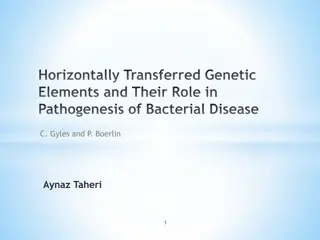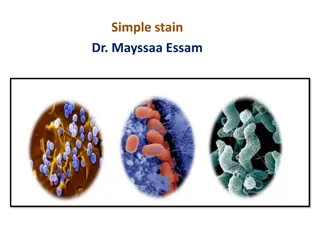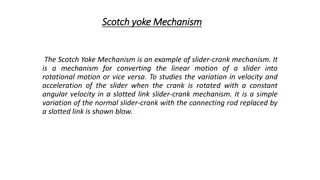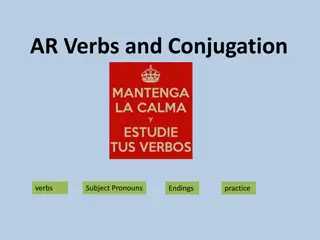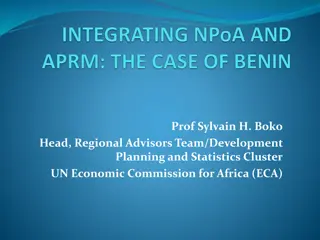Bacterial Conjugation: Mechanism and Applications
Bacterial conjugation is the process of transferring genetic material between bacterial cells through direct contact or bridge-like connections. Discovered in 1946, this mechanism enables the transfer of DNA regions between various bacterial species, including Gram-negative and Gram-positive bacteria. The F plasmid is a key player in conjugation, allowing the introduction of recombinant genes into bacteria. This process has revolutionized molecular biology research, offering a way to exchange genetic information and broaden host ranges for DNA transfer.
Download Presentation

Please find below an Image/Link to download the presentation.
The content on the website is provided AS IS for your information and personal use only. It may not be sold, licensed, or shared on other websites without obtaining consent from the author.If you encounter any issues during the download, it is possible that the publisher has removed the file from their server.
You are allowed to download the files provided on this website for personal or commercial use, subject to the condition that they are used lawfully. All files are the property of their respective owners.
The content on the website is provided AS IS for your information and personal use only. It may not be sold, licensed, or shared on other websites without obtaining consent from the author.
E N D
Presentation Transcript
SEM V- CC12 Unit-6
Recombination Genetics of Bacteria Part I Conjugation
History The process was discovered by Lederberg and Tatum in 1946. Joshua Edward
Bacterial Conjugation Definition Bacterial conjugation is the transfer of genetic material between bacterial cells by direct cell-to-cell contact or by a bridge-like connection between two cells. This takes place through a pilus. Recipients of the DNA transferred by conjugation are called transconjugants.
Bacterial conjugation is the transfer of genetic material between bacterial cells by direct cell-to-cell contact or by a bridge-like connection between two cells. This takes place through a pilus.[2] It is a mechanism of horizontal gene transfer as are transformation and transduction alth ough these two other mechanisms do not involve cell-to-cell contact.[3]
Bacterial Conjugation The process of conjugation can transfer DNA regions of hundreds to thousands of kilobases and has the broadest host range for DNA transfer among the methods for bacterial exchange. Conjugation occurs in and between many species of bacteria, including Gram- negative as well as Gram-positive bacteria, and even occurs between bacteria and plants.
Use and Applications Broad-host-range conjugative plasmids have been used in molecular biology to introduce recombinant genes into bacterial species that are refractory to routine transformation or transduction methods. Although numerous examples of conjugative plasmids exist, conjugation involving the F plasmid is the most common.
Principle of Bacterial Conjugation The process of bacterial conjugation is based on the principle that the plasmid or any other genetic material is transferred from the donor cell to the recipient cell through close physical contact.
The F plasmid is present in one or two copies per cell and is very large (about 100 kilobases). E. coli harboring the F plasmid are referred to as donor (F+or male) cells and E. coli lacking the F plasmid are referred to as recipient (F or female) cells. Only donor cells are capable of transferring the F plasmid to recipient cells.
Principle of Bacterial Conjugation Of all the conjugative plasmids, the F (fertility) plasmid of E. coli was the first discovered and is one of the best-studied
Types of Plasmids 1. Self-transmissible (F-plasmid) plasmid: These plasmid encodes all the functions necessary for their transfer as well as the transfer of other mobilizable plasmid into recipient cell. DNA element and The cell which possess self-transmissible plasmid are called donor cell and other cell which usually don t possess self- transmissible plasmid are called recipient cell.
Types of Plasmids These plasmid contains both Tra gene and Ori T sites These plasmid are known as F-factor or F- plasmid or conjugative plasmid Present in Pseudomonas, E. coli, Bacillus, streptococcus, Staphylococcus, Streptomyces etc
Types of Plasmids 2. Mobilizable plasmid: These plasmid encodes only function for its transfer into recipient cell. mobilizer plasmid is not transferred by itself. It requires the help of self-transmissible plasmid for its transfer.
Conjugation as a brief For transfer of the F plasmid from donor to recipient, intimate contact resulting in mating-pair formation, is required. between cells, The brought by membrane fusion of the two cells by the action of different enzymes. transfer of genetic material is then Following replication transferred into the recipient cell. the of membrane donor fusion, occurs the DNA and is
Steps and Mechanism of Transfer of Plasmid from Donor to Recipient Cell The F plasmid contains tra locus, which includes the pilin. This gene, along with some regulatory proteins results in the formation of pilli on the F+cell surface.
The proteins present in the pilli attach themselves on the F cell surface. The pilli are responsible for making contact between the cells, but the transfer of plasmid doesn t occur through the pilli.
Mechanism of conjugation Conjugation is brought about by 2 genes in self transmissible plasmid, namely transacting gene (Tra gene) and Origin of transfer (Ori T) site I. Tra gene: Tra gene consists of 2 components- Dtr and mpf i. Dtr (DNA transfer and replication) component: Dtr component prepare plasmid for transfer. It includes components such as= relaxases, relaxosome complex and primase.
Mechanism of conjugation Relaxase: Relaxase is a site specific endonuclease which acts on plasmid at its OriT site. Relaxase is transcribed along with the plasmid into the recipient
Mechanism of conjugation Relaxosome complex: It consists of group of proteins clustered around the Ori T site Relaxosome carries three basic functions- it helps relaxase bind to the oriT site and initiates plasmid transfer, relaxosome communicates with the coupling protein of Mpf component which signals relaxase when to cut the plasmid at Ori t site, Helicase is a component of relaxosome which helps to separate the plasmid DNA strands during displacement and transfer of plasmid.
Mechanism of conjugation Primase: Primase has no role in replication of donor plasmid in donor cell The free 3 -OH end created at the nic site acts as a primer in donor cell. Primase is trnasfered to the recipient cell and synthesizes a primer to complete the replication of another strand of plasmid DNA in recipient cell.
Mechanism of conjugation ii. Mpf (Mating pair formation) component: Mpf component holds the donor and recipient cell together, forms a channel through which DNA is transferred and signal Dtr component to initiate transfer. It has 3 components- pilus, channel and coupling protein
Mechanism of conjugation Pilus: Pilus holds donor and recipient cell together It is 10nm in diameter tubular structure with a central channel projecting out of the cell surface. Pili may be structurally long, thin and flexiable and it is encoded by F-plasmid in those cell Incompatibility F-plasmid (Inc F) is a long and rigid pili encoded by pKM101 (Inc N) Short, thick and rigid plasmid is encoded by RP4 (Inc P) Long, thin and flexible pili mediates conjugation in cell in liquid medium Short, thick and rigid pili mediates conjugation in cell fixed to solid support (Agar medium) Inc I plasmid (col 1BP9) encodes both long, thin, flexible pili and short, thick and rigid pilli, therefore it can mediate conjugation in both liquid and solid media
Mechanism of conjugation Channel: Channel are also encoded by Tra gene Channel mediates the transfer of DNA from donor to recipient cell
Mechanism of conjugation II. Ori T site: It is the site where plasmid DNA transfer initiates in donor cell and the site for recyclization in the recipient cell. It is the site which is specifically recognized by relaxase. Any plasmid that possesses Ori T site can be transferred with the help of self-transmissible plasmid Ori T site is a cis-acting site A known Ori T site of F-plasmid has around 300 bp and contains inverted repeats and AT rich sites.
Mechanism of conjugation Plasmid can also mediate the transfer of chromosome because Ori T site and Tra gene are present in plasmid. For transfer of chromosome, plasmid must be integrated with chromosome. The integrated form of plasmid is known as Hfr or High frequency recombination. Plasmid can integrate into chromosome through 2 mechanism. Recombination: plasmid can recombine with chromosome when plasmid and chromosome share common sequences (homologous sequences). Although the sequences of plasmid are unique to that of chromosome they share homology at certain insertion sequences. Transposition: plasmid can insert itself into chromosome by transposons and results in formation of Hfr.
The process occurs during the transfer of F plasmid in E. coli by conjugation Once the conjugation is initiated, enzyme relaxase creates a nick in the conjugative plasmid at the oriT.
The process occurs during the transfer of F plasmid in E. coli by conjugation The nicked strand (called the T strand) then unwinds and is transferred to the recipient cell in the 5 -3 direction.
Process of Conjugation In infrequently (about once in every 10,000 F+cells) becomes associated with chromosome in such a chromosome instead is conjugation tube from donor to recipient cell. certain F+ bacterial cells, the F element the that main a bacterial of way transferred copy through the the In breaks at a particular point and becomes a linear segment of the bacterial chromosome. the insertion process, the circular F element An F+cell that carries such an integrated F element is known as an Hfr cell frequency of recombination). (Hfr stands for the high The integrated F element of Hfr cells is ordinarily replicated passively along with the bacterial
Other conjugative elements Broad-host-range such as many bacterial bacteria to yeast. conjugative be transferred genera and plasmids, among even RK2, can from In harbor transmissible because they lack some or all of the necessary tra addition, there but exist that plasmids are that self- oriT, not
Other conjugative elements However, if the tra genes are provided on a separate replicon, these plasmids can be mobilized for transfer. Such plasmids are called mobilizable plasmids.
Examples of bacterial conjugation Conjugative plasmids encoding antimicrobial resistance genes are called R plasmids which are transferred through Shigella sp that might result in a widespread outbreak of antibiotic- resistant Shigella-mediated dysentery.
Summary Steps of bacterial conjugation Step I: Pilus formation Donor cell (F+cell) produces the sex pilus, which is a structure that projects out of the cell and begins contact with an F (recipient) cell.
Steps of bacterial conjugation: Step II: physical contact between donor cell and recipient cell The pilus enables direct contact between the donor and the recipient cells forming conjugation tube
Steps of bacterial conjugation: Step III: transfer of F- plasmid F-factor opens at replication origin (Ori T site). one strand of F-factor is cut down at origin and then 5 end of this strand enters into recipient cell.
Steps of bacterial conjugation Step 4: complementary strand synthesis In the last step, the donor cell and the recipient cell, both containing single-stranded DNA of F-plasmid A complementary strand is then synthesized in both donor and recipient cell, Now the recipient cell also contain a copy of F-plasmid and become a donor cell.
Horizontal Gene Transfer as a Mechanism of Genetic Change DNA replicated only if replicon has origin of replication, Plasmids, chromosomes. DNA fragments added to chromosome via homologous recombination. Only if sequence similar to region of recipient s genome
Permission required for reproduction
8.8. Conjugation Conjugation: DNA transfer between bacterial cells Requires contact between donor, recipient cells Conjugative plasmids direct their own transfer Replicons F plasmid (fertility) of E. coli most studied Other plasmids encode resistance to some antibiotics Spread resistance easily
8.8. Conjugation (continued ) F plasmid of E. coli: F+ cells have, F do not Encodes proteins including F pilus Sex pilus Brings cells into contact Enzyme cuts plasmid Single strand transferred Complementary strands synthesized Both cells are now F+
